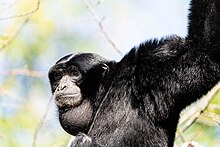
Back Himbèe ACE سيامنغ Arabic قرد السيامنج ARZ Tcardiol (Symphalangus syndactylus) AVK Сиаманг Bulgarian Siamang Breton Imbo BTM Siamang Catalan Symphalangus syndactylus CEB Siamang Czech
| Siamang[1] | |
|---|---|

| |
| Scientific classification | |
| Domain: | Eukaryota |
| Kingdom: | Animalia |
| Phylum: | Chordata |
| Class: | Mammalia |
| Order: | Primates |
| Suborder: | Haplorhini |
| Infraorder: | Simiiformes |
| Family: | Hylobatidae |
| Genus: | Symphalangus Gloger, 1841 |
| Species: | S. syndactylus
|
| Binomial name | |
| Symphalangus syndactylus (Raffles, 1821)
| |

| |
| Distribution of the siamang | |

The siamang (/ˈsiːəmæŋ/, also UK: /ˈsaɪə-/;[5][6] Symphalangus syndactylus) is an endangered arboreal, black-furred gibbon native to the forests of Indonesia, Malaysia, and Thailand. The largest of the gibbons, the siamang can be twice the size of other gibbons, reaching 1 m (3.3 ft) in height, and weighing up to 14 kg (31 lb). It is the only species in the genus Symphalangus. Fossils of siamangs date back to the Middle Pleistocene.[2]
Two features distinguish the siamang from other gibbons. First, two digits on each foot—the second and third toes—are partially joined by a membrane, hence the specific name syndactylus, from the Ancient Greek σύν, sun-, "with" + δάκτυλος, daktulos, "finger". Second, a large gular sac (throat pouch), found in both males and females of the species, can be inflated to the size of the siamang's head, allowing it to make resonating calls.
Two subspecies of the siamang are the nominate Sumatran siamang (S. s. syndactylus) and the Malaysian siamang (S. s. continentis, in Malay Peninsula).[7] Otherwise, the Malaysian individuals are only a population. The siamang occurs sympatrically with other gibbons; its two ranges are entirely within the combined ranges of the agile gibbon and the lar gibbon.
The siamang can live to around 40 years in captivity.[8]
While the illegal pet trade takes a toll on wild populations, the principal threat to the siamang is habitat loss in both Indonesia and Malaysia. The palm oil production industry is clearing large swaths of forest, reducing the habitat of the siamang, along with those of other species, such as the Sumatran tiger.
- ^ Groves, C. P. (2005). "Order Primates". In Wilson, D. E.; Reeder, D. M (eds.). Mammal Species of the World: A Taxonomic and Geographic Reference (3rd ed.). Johns Hopkins University Press. p. 181. ISBN 978-0-8018-8221-0. OCLC 62265494.
- ^ a b K. Suraprasit, J.-J. Jaegar, Y. Chaimanee, O. Chavasseau, C. Yamee, P. Tian, and S. Panha (2016). "The Middle Pleistocene vertebrate fauna from Khok Sung (Nakhon Ratchasima, Thailand): biochronological and paleobiogeographical implications". ZooKeys (613): 1–157. Bibcode:2016ZooK..613....1S. doi:10.3897/zookeys.613.8309. PMC 5027644. PMID 27667928.
{{cite journal}}: CS1 maint: multiple names: authors list (link) - ^ Nijman, V.; Geissmann, T.; Traeholt, C.; Roos, C.; Nowak, M.G. (2020). "Symphalangus syndactylus". IUCN Red List of Threatened Species. 2020: e.T39779A17967873. doi:10.2305/IUCN.UK.2020-2.RLTS.T39779A17967873.en. Retrieved 19 November 2021.
- ^ "Appendices | CITES". cites.org. Retrieved 2022-01-14.
- ^ "siamang". Lexico. Archived from the original on 2022-04-26. Retrieved 2022-04-26.
- ^ "Definition of siamang | Dictionary.com". www.dictionary.com. Retrieved 2022-02-14.
- ^ Geissmann, Thomas. "Gibbon Systematics and Species Identification". Retrieved 2006-04-13.
- ^ Gron KJ. 2008 May 20. Primate Factsheets: Siamang (Symphalangus syndactylus) Taxonomy, Morphology, & Ecology . http://pin.primate.wisc.edu/factsheets/entry/siamang>. Accessed 2015 June 9.
© MMXXIII Rich X Search. We shall prevail. All rights reserved. Rich X Search
